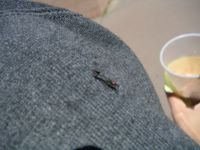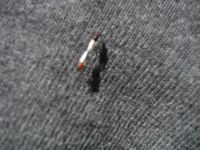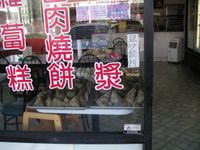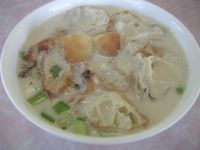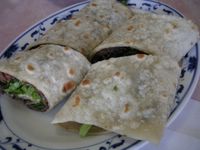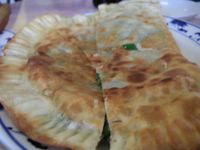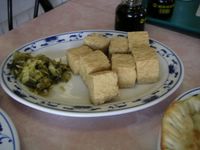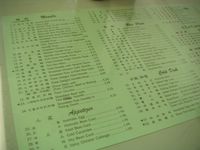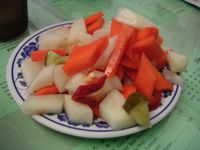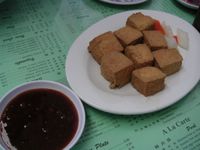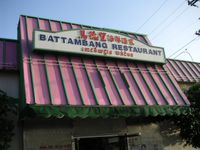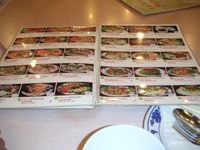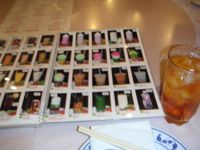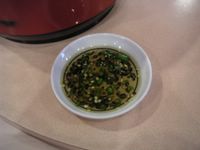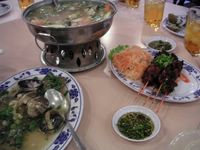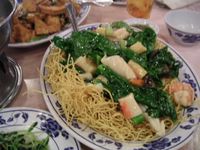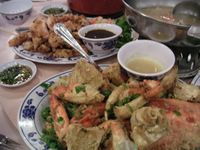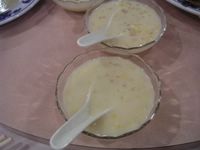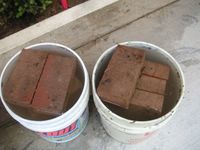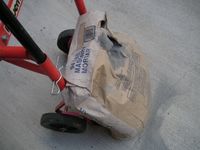L's mother hails from Northeastern China. She's pretty knowledgeable about making the common food from that area, in particular dishes that use dough. I asked her to teach me her version of some simple dishes that I like to order when I go out to eat.
Today, she taught me 2 dishes: 韮菜盒子 [pan-fried chive pie], and 餃子 (dumplings).

Chinese homecooking: 韮菜盒子 main ingredients
Both of these dishes are pretty simple dishes, and normally just use up leftovers. Their fillings can be very similar (or not), but today we decided to just use what was around the kitchen.
The main ingredients of 韮菜盒子 are 韮菜 (Chinese chive, aka garlic chive) and flour.
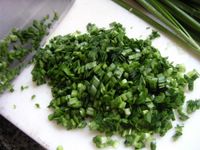
Chinese homecooking: diced 韮菜
First, you dice/mince the 韮菜. The taste of 韮菜 can be pretty overpowering, exactly what is needed for this peasant-y dish.
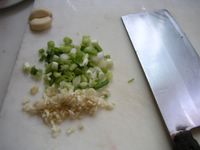
Chinese homecooking: diced scallions and garlic
Next, dice scallions (green onions) and garlic. These two ingredients are so ubiquitous in and crucial to Chinese cooking that I can't imagine life without them.
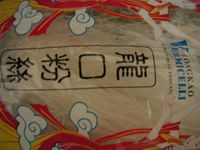
Chinese homecooking: 粉絲 mungbean noodle/vermicelli
Often added to 韮菜盒子 are 粉絲 (mungbean vermicelli) and dried shrimp. As I posted before, sometimes eggs are added. But today, we are only adding the 粉絲 and dried shrimp.
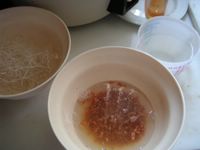
Chinese homecooking: rehydrating 粉絲 and dried shrimp
Soak both the 粉絲 and dried shrimp in warm water.
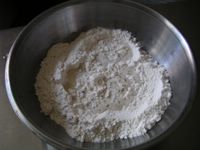
Chinese homecooking: add flour to mixing bowl
Now it's time to make the dough. I don't have any precise instructions here. Basically, add water little by little to the dough till it comes together into a nice ball. This isn't baking or really all that precise.
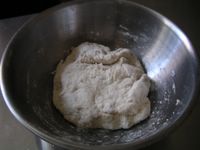
Chinese homecooking: add water, do some sloppy kneading
Later, let the dough stand covered by a moistened cloth for several hours.
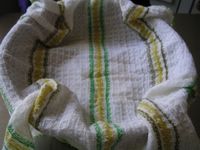
Chinese homecooking: let dough stand covered by moistened cloth
As the dough rests, start making the 韮菜盒子 filling. First, add the diced chive to the mixing bowl.
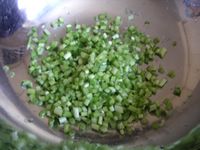
Chinese homecooking: add diced chives to bowl first
Next, mix in the rehydrated shrimp and mungbean noodle.
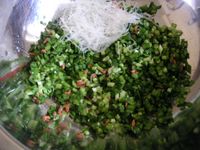
Chinese homecooking: add rehydrated shrimp and 粉絲
Add soy sauce or salt, and pepper to taste. The rehydrated shrimp will add its own salty flavor, so take that into consideration.

Chinese homecooking: add soy sauce or salt and pepper to taste
Once all the above ingredients have been combined, drizzle in some sesame oil. We generally leave this to the end since it is so aromatic and pungent that it will completely obliterate the scent of the other ingredients and prevent you from deciding whether you need more of an earlier ingredient.
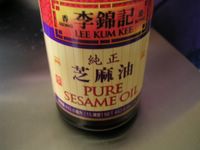
Chinese homecooking: Mix, then add sesame oil
Mix well once more, then let the combined ingredients rest for a while.
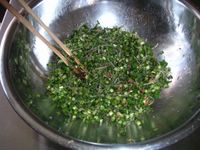
Chinese homecooking: Mix again, then let mixture stand for a while
Once the dough has rested for a few hours, take it out of the mixing bowl and divide it. Each section will be rolled out and cut into two half-moon shapes, one forming the base and one forming the top of the 韮菜盒子.
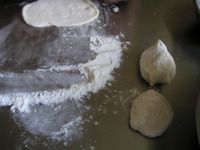
Chinese homecooking: divide dough
Once the dough has been rolled out to your desired thickness (not too thick, as the 韮菜盒子 should cook quickly on the stove), add filling to the base.

Chinese homecooking: add filling to one rolled out dough piece
Drape the top layer over the filling, and crimp the edges of the bottom and top layer together to form a nice seal.
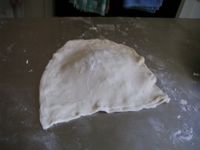
Chinese homecooking: add another layer on top of filling and crimp edges
Heat up a wok with oil and plunk the 韮菜盒子 in, maybe 1-3 at a time, and fry on both sides.
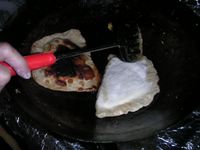
Chinese homecooking: fry up 韮菜盒子 in wok
They can be fried till very crisp, or just until the filling cooks and the exterior turns brown.
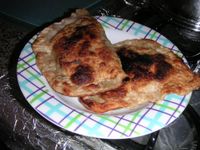
Chinese homecooking: finished 韮菜盒子
Once you cut upon the 韮菜盒子, add some good vinegar inside and chow down once they have cooled down a bit.
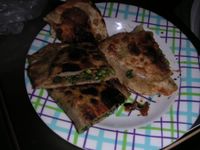
Chinese homecooking: 韮菜盒子, cross-sections
We had a little of the 韮菜盒子 filling left over, as well as some pork that had been freezing for several weeks in the refrigerator, so we added the defrosted pork to mixing bowl with the leftovers. We also had purchased fish paste at the market, and dumped it in as well. What we had forgotten to buy was some fresh or frozen shrimp to cut up coarsely and add to the mix. That would have made our dumplings better, but ah well.
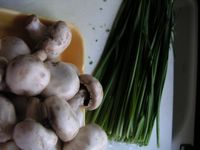
Chinese homecooking: additional ingredients to make 餃子 [dumplings]
Fresh ordinary mushrooms aren't typically a part of the dumpling filling we make, but I like mushrooms so I decided we should add them in. We cut up additional chive in addition to the mushrooms, and added them to the pork mix.
I'd like to take a detour to point out the sacred triumvirate of cooking ingredients in Chinese cooking, which would be: garlic, ginger, and green onions. L's mother was telling me how these ingredients absolutely need to be added to most of the mass-market meats (read pork) bought here in the U.S. since they're fairly tasteless.
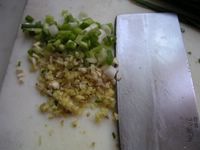
Chinese homecooking: the sacred triumvirate of green onions, garlic, and ginger
Minced garlic, green onions, and ginger were added to the pork mix, in addition to salt and pepper. Sometimes people add in an egg as a binder for the combined ingredients, but we only added some more sesame oil.

Chinese homecooking: 餃子餡兒 dumpling filling
You can make your own dumpling wrappers, but we used storebought ones. In this case, we used up 3 packages of 鍋貼 wrappers, since they are generally thicker and larger than normal 餃子 wrappers.
The only instruction I can give for wrapping the dumplings is to make sure you get a very good seal on the dumplings that will be boiled, otherwise they'll explode in the pot. We decided to make both fried and boiled dumplings, which would translate to 鍋貼 [potstickers] and ?? 餃 [boiled dumplings].

Chinese homecooking: 包餃子 [stuff dumplings]
To cook 鍋貼, first coat the bottom of a large skillet with oil, and arrange the 餃子 so they are just barely not touching each other. The heat should be on high heat.
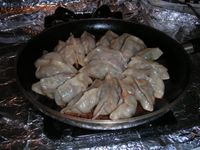
Chinese homecooking: 鍋貼 [pan-fried dumplings, potstickers]
Later, once the 鍋貼 have fried for about 5-10 minutes covered, add water to submerge the 鍋貼 about 1/2 to 3/4 of the way, then cover the skillet again. When the water has mostly evaporated, fill the skillet with more water and cover again to cook.
At this point, you can check to see if the 鍋貼 are done, or if you need to add water a third time and go through the same cooking process. When we made it this time, we only had to add water once. When cooked, the 鍋貼 should have a crisp brown bottom and the smell of the cooked filling should be strong.
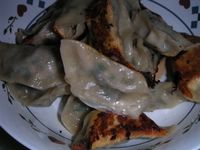
Chinese homecooking: 鍋貼, in bowl
You can also take the 餃子 and boil them in a pot of water to make ....
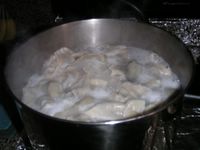
Chinese homecooking: 水餃, pot of boiling dumplings
To eat, dip the various dumplings into vinegar, soy sauce, hot sauce, sesame oil, and whatever additional spices you'd like. Some people add a raw egg and scallions.
